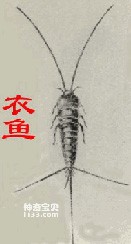Clothes stored at home may become infested by insects if you are not careful. The worst thing is that woolen sweaters, woolen coats, expensive suits, etc. are all affected by moths to varying degrees, which makes people worried and panicked. They are really helpless, so they urgently need to know the solution. I would like to take this opportunity to introduce the most annoying common moths on clothes to readers so that they can identify, prevent and treat them.

(1) A skin beetle larvae with long spines all over its body. If there are holes in wool, feathers, or woolen clothes in every household, they are mostly small round holes and black holes. The body of the small round beetle is round like a soybean, and there are three obvious wavy patterns on the wing sheaths. The body of the larvae is densely covered with various kinds of stinging hairs, which makes it look a bit scary. They not only damage wool and silk clothing, but also feed on tonics, flour, peanuts, soybeans, starch, spices, and animal specimens. Therefore, when storing valuable woolen clothes at home, do not store the things they eat near suitcases or cabinets.
The black skin bag is slightly larger than the small round skin bag. The adults are oval and dark brown in shape. They often fly outdoors and gather on flowers to feed on pollen and nectar and engage in mating activities. The larvae are reddish-brown, with a tuft of long hairs behind the tail. Larvae often gather in corners of walls, under floors, in gaps between masonry, or in dust and debris, and spend the winter there. Larvae can also be found on various cereals, flours, beans and old paperboard walls, but they are not very harmful. On the contrary, it can often cause great harm to woolen clothes, carpets, wool, and items containing silk, wool, bristles, feathers, animal skins, etc.
(2) Clothes moths flying and laying eggs. If you find small moths flying in the closet, mostly bag moths and curtain moths, it means that the clothes in the closet have been infested by insects. But it’s not the little moths that eat the clothes, but their larvae. Clothes moths belong to the order Lepidoptera and the family Cerealidae. These two moths often coexist. The larvae are almost white and like the dark. The adults have similar appearances and are difficult to distinguish, but the larvae are easy to distinguish. When the bag moth larva crawls, it often has a bag attached to its body. This is a bag formed by connecting the silk it spins and the fibers in its food, hence its name. There are openings at both ends of the bag. As the insect grows, the bag continues to expand. The larvae can turn around in the bag and feed from both ends without changing the position of the bag; while the larvae of the curtain moth do not have this bag. If the weather is humid and the suitcase is damp, the development of larvae will be accelerated and the feeding activity will be at its peak. In addition to causing damage to rabbit fur and woolen sweaters, the two types of clothes moths also damage carpets, tapestries, and even furniture decorations (chair cushions, sofa covers, etc.).
(3) Silverfish with long tail. The sweater fish, commonly known as silverfish, belongs to the order Thysanophora and the family Silverfish, and is also a common clothing borer. Its body is slender and soft, with long whiskers behind its tail. The sweater fish is a nocturnal insect that lives in dark and humid places. For example, when an umbrella is not used for a long time, it can be seen as soon as it is opened. It will be frightened by light or the slightest sound and flee quickly. In addition to causing damage to clothes, sweater fish can also eat food such as paper, peanuts, sesame seeds, and even Chinese medicinal materials.

(4) Ways to deal with clothing moths. When drying and storing clothes every year, avoid pest mating and egg-laying seasons. When hiding clothes in people's boxes, soft-touch, valuable silk and wool clothes and rough-touch clothes should be stored in separate boxes, and anti-moth drugs (such as mothballs) should be placed in the suitcases. This is basic common sense to prevent clothing from getting mothed. So how to deal with borers?
① Manual capture. If you find a hole or a moth, quickly search for the moth's nest with the suitcase, and beat it hard to let the moth fall to the ground outside the nest and kill it.
②Clean, dry and iron. Wash heavily damaged clothes with water, dry them in the sun and then iron them to completely remove the eggs hidden in the gaps in the clothes. Clothes that cannot be washed with water can be sent to a laundry and dyeing shop for dry cleaning or fumigation.
③Use pesticides to kill insects. Pour 200 to 500 ml of 0.5% permethrin into a small sprayer, spray it on the moth-infested clothes, then fold it up, wrap it in plastic film, seal it for 48 hours and then expose it to the sun, which can kill most moths. If the injury is serious, seek help from relevant professionals.
animal tags: borer moth silverfish pest
We created this article in conjunction with AI technology, then made sure it was fact-checked and edited by a Animals Top editor.